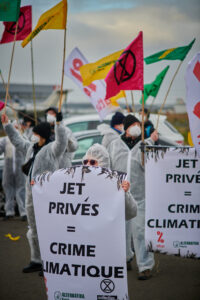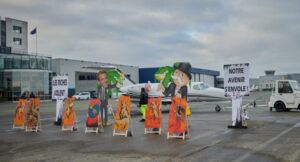Minds of the Movement
An ICNC blog on the people and power of civil resistance
by Charlotte SeccoFebruary 15, 2022
Nonviolent struggle and how it shapes politics are largely misunderstood topics in France.
Why, and what can we—scholars, students, and professors—do to advance this research priority?
Lisez cet article en français ici.
As part of my Master’s research in France, I studied and participated in two different nonviolent movements for the climate: Alternatiba and Extinction Rebellion. My research has affirmed several points from the broader literature of nonviolent action, but also led to some surprises about how people view nonviolent action in my country.

"Private jets = climate crime." Alternatiba, Attac and Extinction Rebellion direct action for the climate, Paris-Le Bourget airport, January 2022. Credit: Le Duq/Alternatiba Paris Facebook.
Alternatiba and ANV-COP21 are two citizen movements born in 2013 and 2015 whose objective is to take up the climate challenge through nonviolent struggle. The activists have notably made themselves known by removing presidential portraits from town halls all over France—portraits that regularly reappear during various demonstrations to underline presidential inaction. Extinction Rebellion was born in the United Kingdom in 2018, with cells popping up all over the world since. With four core demands and 10 principles, they regularly organize anti-advertising campaigns and blockades against polluting industries, such as the June 2021 blockade of the Lafarge cement plant.
It is clear that these environmental movements in France are choosing nonviolent direct action because they feel institutional politics by itself is inadequate to respond to their demands. They further derive strategic benefit from remaining nonviolent. These movements sometimes engage in property degradation, which contributes to the debate: is material degradation violent or nonviolent? Regardless, these actions are to be distinguished from vandalism, because it is a political gesture claimed and executed with an open face.
Yet what has surprised me most in this process is not the movements themselves, but rather the discovery that most French political scientists (and the French public more broadly) share a general misunderstanding of what nonviolent struggle is and how it shapes politics. This is what some folks in my circles have started calling “the French paradox”: The French are known world-wide for our massive marches in Paris’ République and Bastille plazas; our crippling, weeks-long public transportation strikes; our extremely active and strong teacher unions… yet our academia don’t specifically study why nonviolent struggle is powerful. And politicians will more often point to the violent actions that can occur rather than see movements’ nonviolent aspects.
The French paradox

"The rich are flying" which in French reads the same as "the rich are stealing"; "Our future is flying away." Paris-Le Bourget airport, January 2022. Credit: Le Duq/Alternatiba Paris Facebook.
University departments view this topic (often referred to as la non-violence in French, conflating both nonviolent struggle and the moral tradition of eschewing violence) as something out of a Care Bears cartoon (Les Bisounours). French people have for centuries engaged in nonviolent action for rights, justice, freedom, and sustainability, yet there is little funding for research on nonviolent action. It’s simply not on the academic or policy agenda, despite its omnipresence in our everyday lives.
As we are proud of events like the French Revolution, we should also learn more about nonviolent movements. They deserve more attention than they are receiving, because of their pathbreaking progress for humanity—against slavery, for better working conditions, and much more. Perhaps more importantly, they deserve more attention because of what we can learn from them about co-existing sustainably and in peace on this planet, and in societies that embody our virtues of truth and justice.
What can we learn from movements?

Nonviolent movements often rely on inclusive decision-making, a model that is coherent with the unity and vision their struggles are centered around. Paris-Le Bourget airport, January 2022. Credit: Le Duq/Alternatiba Paris Facebook.
I observed that Alternatiba and Extinction Rebellion are trying out new forms of collective organization: non-hierarchical decision-making processes that rely on consensus, which are the very definition of inclusiveness. In this way, their mobilization is not only vindictive but also representative of the changes the activists wish to see happen in society: a nonviolent, horizontal society that respects the living. The essence of these movements is therefore in the articulation of "force of opposition - source of proposal". They fight against a system while prefiguring the solutions they are struggling to advance.
This makes me wonder: What would happen in a society where we educate children not only about violent revolution but also nonviolent revolution?
That nonviolent action is not unanimously accepted among the French public and academia is not a problem to me—on the contrary. The debate allows us to take a step back and continually question this practice, to improve it. However, I do not agree with those who say that nonviolent action is at the service of the state. Nonviolent action has the merit of allowing ordinary people, regardless of their physical ability, gender, age, and so on, to leverage pressure via collective participation. The inclusiveness of nonviolent action is a major asset that should not be minimized.
What way forward?
It would be an exaggeration to say that no one is interested in this topic in France. I have had the opportunity to work for the Institute for Research on Nonviolent Conflict Resolution, the Committee for Unarmed Civilian Peacekeeping, the Nonviolence XXI Association, and the journal Alternatives non-violentes. These are all structures that deserve more visibility... and more resources. I had the opportunity to work on two pedagogical projects related to nonviolent action: a university diploma on unarmed civilian peacekeeping and a course on conflict analysis where I led a group of students in translating into French Swarthmore College’s Global Nonviolent Action Database.
In my opinion, it is in the best interest of universities to pursue such collaborations. But what can we, scholars, students, and professors do to advance this research priority? We can network with professors in countries where nonviolent action is studied (the United States and the United Kingdom, for example) to learn how the field grew and tips for helping it grow. We can petition our faculty and university leadership to offer classes on nonviolent action (the Institut Catholique de Paris is currently offering a class on Nonviolence and Politics to undergraduates). We can write op-eds about nonviolent struggle as a political strategy to end oppression, to drum up public interest in the topic.
A prism for understanding society
The misunderstanding around this topic in France stems from terminology: People use nonviolence to refer to both a set of ethical beliefs and a political strategy. The distinct concepts of nonviolence (a set of beliefs) and nonviolent struggle (a type of conflict) are certainly two sides of the same coin. Yet distinguishing these concepts gives us more clarity on how these ideas are deployed, who appropriates them, the debates that cross them... all these dynamics allow us to understand an era, a struggle, and society more broadly.
Regardless of terminology, what is clear is that young people are already showing an interest in this action strategy (Youth for Climate, Fridays for Future...). Nonviolent struggle thus has a future because the youth are making it their own. This trend—as well as the culture of nonviolence more broadly, in my opinion—must be supported at a time when society is becoming increasingly divided.

Charlotte Secco
Charlotte Secco is a research associate at the Institute for Nonviolent Conflict Resolution. Her topics of interest are nonviolent struggle and the climate movement. She served as a peace witness in Palestine and is involved in promoting both unarmed civilian peacebuilding and the study of nonviolent struggle and nonviolence in France.
Charlotte Secco est chercheuse associée à l’Institut de recherche sur la Résolution Non-violente des conflits. Ses sujets de prédilection sont la lutte non-violente et le mouvement climat. Elle a été témoin de paix à Jérusalem et a participé à faire connaitre l’intervention civile de paix, ainsi que l’étude de la lutte non-violente et la non-violence, en France.
Read More